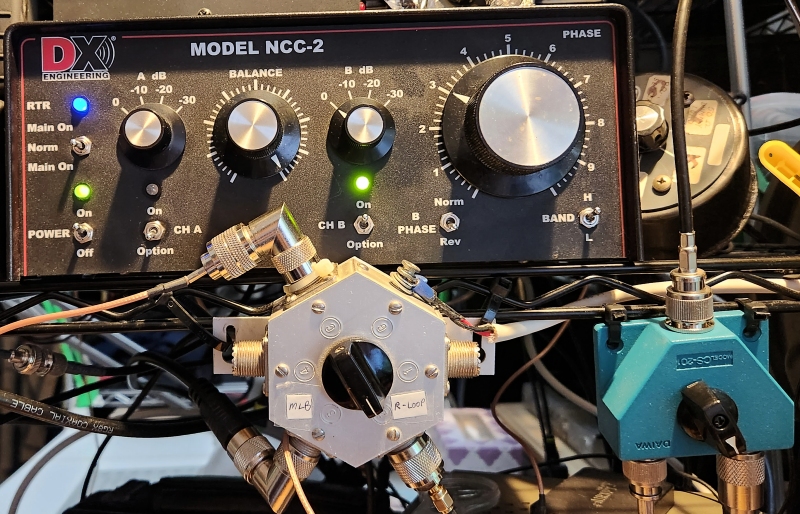Many thanks to SWLing Post contributor, TomL, who shares the following guest post:
Old Fashioned Band-Scan after the Solar Storms
by TomL
This is just an old fashioned band scan to randomly see what I could hear after last week’s solar perturbations when the Solar Flux Index went well over 200. I considered what I could hear on the shortwave broadcast bands, even though the SFI had quieted down to around 135. Would the ionosphere still be holding on to the charge built up during the solar storms? The date and time was January 30, 2023 around 1400 through 1600 UTC. By the way, as of today (February 2), the bands are dead and cannot hear any of these even though the Solar Flux is about the same!
I will not have time to describe my antenna setup now at my noisy Condominium in detail. I have been experimenting with a DX Engineering NCC2 antenna phasing device for the past year with somewhat good results. I had to place dedicated receive antennas in many different ways in order to find an arrangement that works in conjunction with the two Ham Radio antenna wires out on the porch. Sometimes it helps by lowering the noise, sometimes the native antenna by itself, or peaking the signal, has better reception even though it might be slightly more noisy. By matching one of two receive-only antennas (the left Heathkit switch) with one of the Ham Radio antennas (the right Daiwa switch), I can usually eke out some extra decibels of signal-to-noise improvement.
On this day, I woke up thinking about just tuning to the 31 meter band. It ended up that I kept going up the dial and just kept recording from my AirSpy HF+ SDR. Below are ten audio clips, mostly in Chinese or Other, and mostly strong stations that many of you can easily hear, but for me can only be done outdoors in the zero-degree weather. Some are listed as only 1 kW power. All broadcast parameters are from the short-wave.info web site, so I hope they are accurate (Station, Language, Power & Location, Time & Frequency). Some noise reduction done in Audacity and Normalized to broadcast volume (-1dB) but turn up the volume anyway. Enjoy!
Audio Clips
- USA tax dollars at work. Pleasantly surprised to see VOA from Tinang Phillippines booming in:
VOA, Chinese, 250kW Tinang Philippines, 1415 UTC 9605 kHz
- Dominant station hosts talking with VERY faint other signal that pops up at the very beginning and halfway through (not sure which station is which but the Beijing station is listed as non-directional):
R.Taiwan Intl & CRI1, Chinese, 100kW Taiwan & China, 1418 UTC 9660 kHz
- MOAR USA tax dollars at work. An extended clip from a station a rarely get to hear. Interesting programming with host and changing background music as he tells multiple stories plus a song:
R.Free Asia, Chinese, 250kW Kuwait, 1511 UTC 11765 kHz
- What is Amharic? Nice African music, station ID, interval signal:
Vatican R., Amharic, 250kW Vatican City, 1555 UTC 13830 kHz
- Why do some Muslim language stations have very soft modulation with deep voiced male announcers? Makes it impossible to hear any syllables. First time I have heard this station:
R.Danaga, Dari, 1kW Issoudun France, 1604 UTC 15550 kHz
- Preach out those demons, Brother!!!
WJHR, English, 1kW Milton FL USA, 1609 UTC 15555 kHz (USB)
- Have always seen this listed but first time to hear it. See this write up about Japanese kidnapped to North Korea during late 1970’s & 1980’s, it is broadcast to them – https://www.vk5pas.com/furusato-no-kaze-japan.html
Furusato No Kaze, Japanese, 300kW Taiwan, 1611 UTC 9690 kHz
- R.Argentina on WRMI non-directional 1kW in German:
WRMI-RAE, German, 1kW Ockeechobee FL USA, 1613 UTC 15770 kHz
- Muslim language; reading or preaching:
R.Algerienne, Arabic, 1kW Bechar Algeria, 1627 UTC 15410 kHz
- Caught the very end of this broadcast and it went off the air:
IRRS Oromia Natl Media, Oromo, 1kW Romania, 1629 UTC 15850 kHz



You might also like to use https://www.sws.bom.gov.au/HF_Systems/6/9
How cool! Excellent results! Isn’t it amazing how good conditions have been? It’s so nice to see the upper bands active again. Cheers!
Yes, the solar cycle is making shortwave fun again!